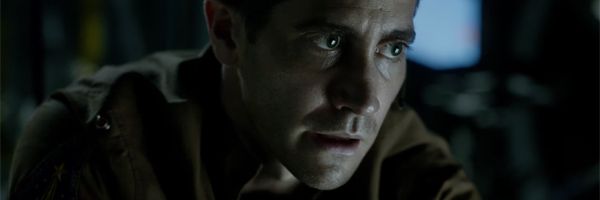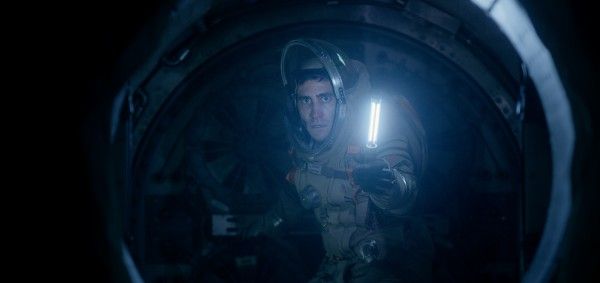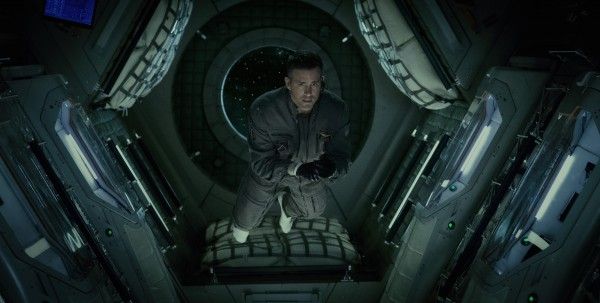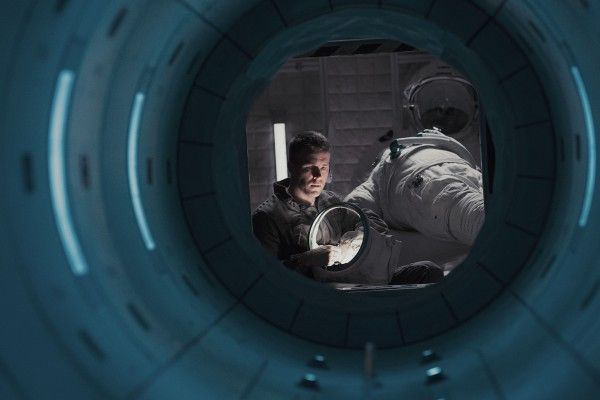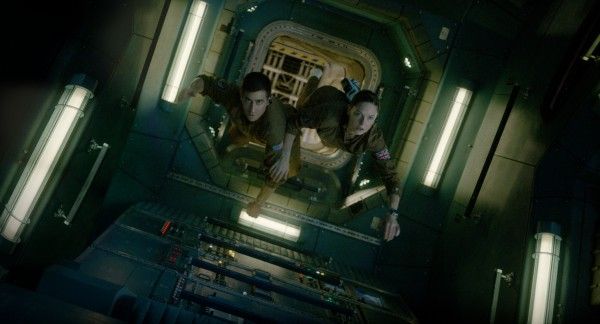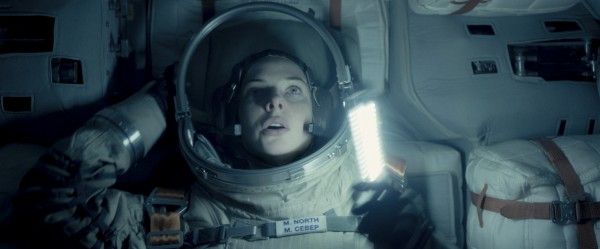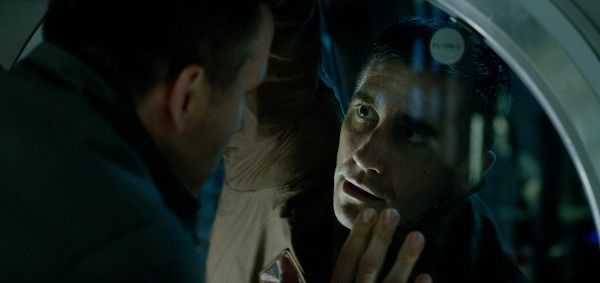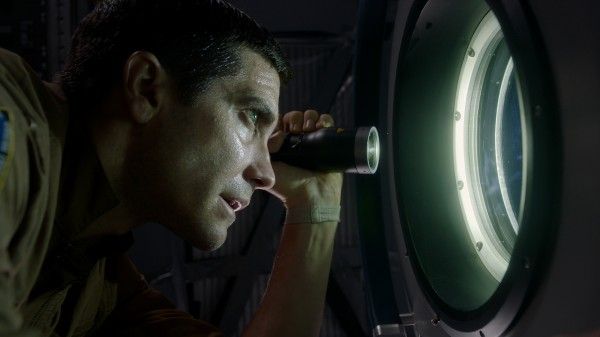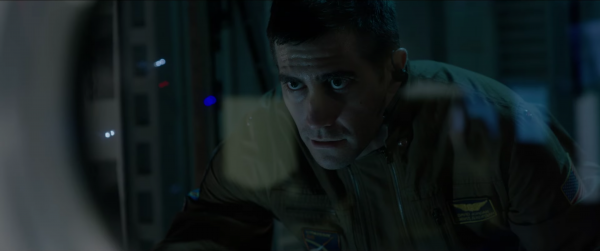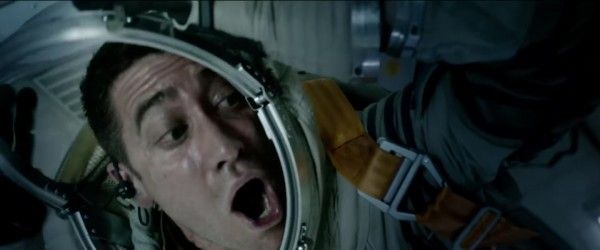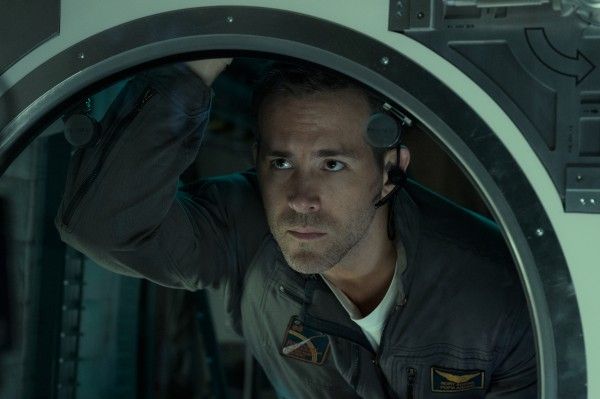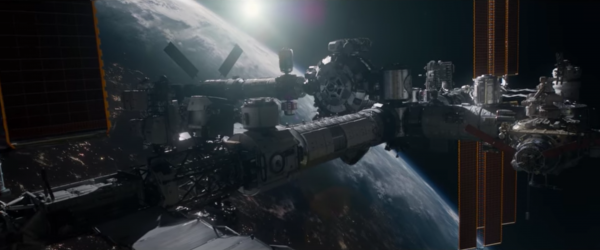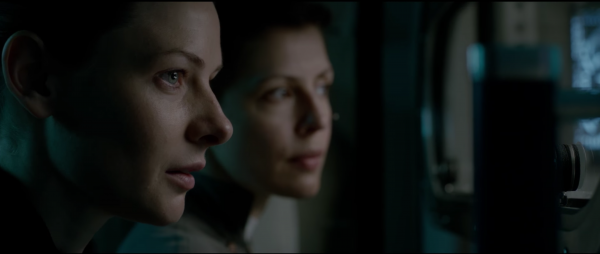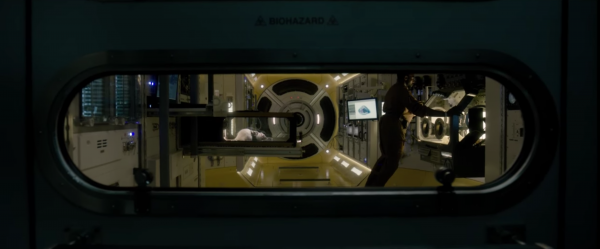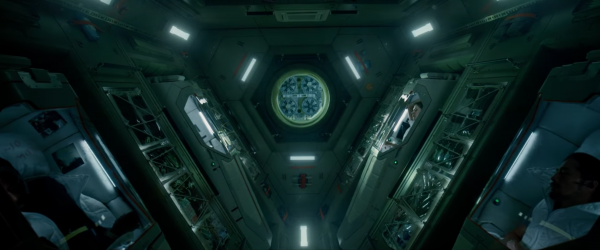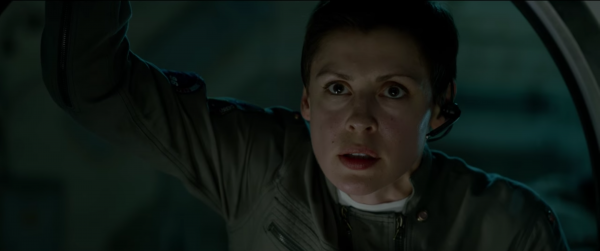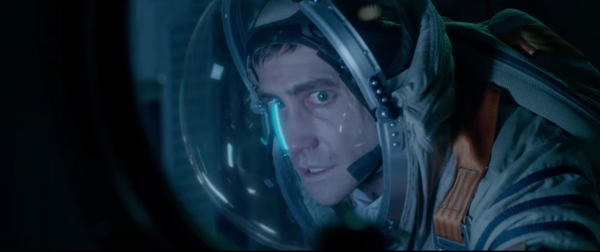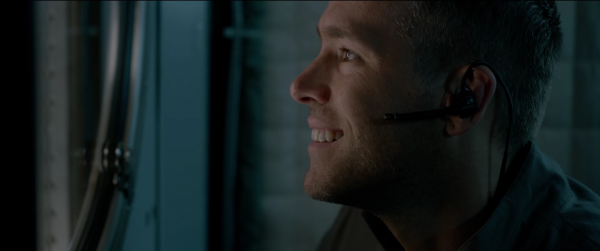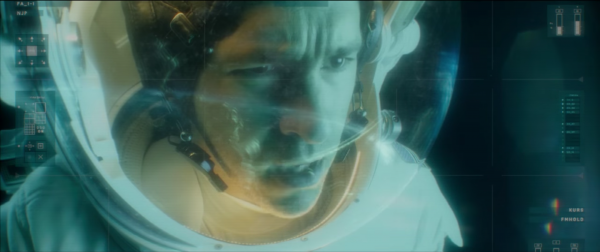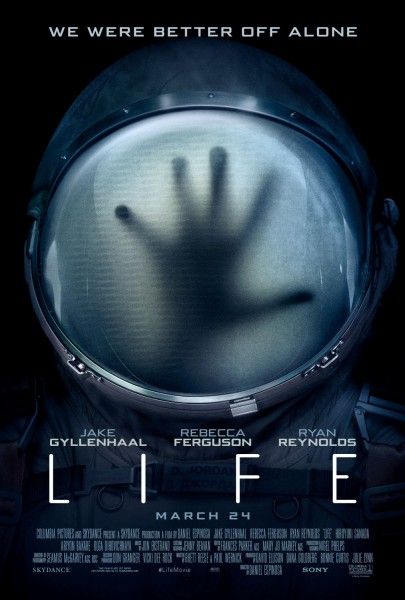Last summer, when director Daniel Espinosa’s Life was filming outside London, I got to visit the set with a few other reporters. The movie, which stars Jake Gyllenhaal, Rebecca Ferguson, Ryan Reynolds, Olga Dihovichnaya, Hiroyuki Sanada and Ariyon Bakare, revolves around the six-member crew of the International Space Station as they come into contact with the very first evidence of biological life on Mars: a small, single-celled organism. As they begin to research the specimen, however, this “life” proves far more dangerous than they could have ever imagined. Life was written by Deadpool’s Paul Wernick and Rhett Reese and produced by Skydance’s David Ellison and Dana Goldberg along with Bonnie Curtis and Julie Lynn.
During a break in filming I got to participate in a group interview with the producers. While they were very guarded about revealing too many of the films secrets, we did learn how the projects came together, how the first draft by Paul Wernick and Rhett Rheese is very close to what audiences will see, that the film takes place in a very near future over a few days, why they went with director Daniel Espinosa, how it was always going to be rated R, how almost the entire movie takes place on the International Space Station in zero G, casting the picture, and so much more. If you’re curious about how this film was made and what they’re trying to do with it, you’ll learn a lot reading this interview.
But before getting to it, I’d suggest you watch the trailer for Life so you can get a feel for the tense thriller. Life invades theaters March 24, 2017.
Question: What was it about this material and story that said, “We need to be involved, we need to make this”?
David Ellison: Sure. Well, it was something that we grew out of Skydance. So I guess we’re biased in saying that we fell in love with it. But, ah — We were in post-production with [screenwriters Paul] Wernick and [Rhett] Rheese on G.I. Joe: Retaliation and Dana and I had always wanted to do an incredibly tense science-fiction thriller on the I.S.S. all in zero G, and this was right around the same time that Mars Curiosity had just landed on Mars, and we kind of got the idea of, what if the Curiosity Rover discovered life on another planet — you know, a single-celled organism — and brought it back to the I.S.S. for analysis and once you introduced it to an environment it started to display signs of intelligence? And that was really the core concept that we fell in love with and pitched to Paul and Rhett. They came back a couple of weeks later with a fully fleshed-out pitch for the movie and pitched the two of us [believe he’s talking about him and Dana Goldberg] at our office at Paramount and we fell in love with it. And very thankfully, the very first draft of that script is very reflective of the movie we’re making today.
Which is kind of unusual.
David Ellison: Yes. Yes.
What do you feel comfortable saying about the film in terms of story and characters?
[They all laugh]
Dana Goldberg: Not a ton.
Well, there have been a lot of sci-fi movies, there have been a lot of “finding life on other planets”type movies. You know, Alien, that sort of thing. What sets this movie apart from the genre?
Dana Goldberg: I’ll say that I think one of the things that sets it apart is that we want this movie to feel very real. As David said, it’s inspired by real-life events and the timing of our film is somewhere in the very near future, but — and these ladies will speak to it — so much of what you’re going to see in this film, from the design of the actual ship to what is going on there, is very realistic, incredibly realistic and they will talk about numerous consultants who have ensured that. But that’s what we think differentiate’s it. This isn’t set 100 years from now or 75 years from now, and this crazy thing could happen one day. We’re set aboard the I.S.S. and, as David was saying, it’s not that far off what we’re talking about. He mentioned Rhett Rheese and Paul Wernick, who obviously wrote Deadpool and wrote this for us. They were very proud a couple weeks ago. They sent out an email to all of us saying that, basically, NASA had tweeted out that the next Mars mission, the goal was to bring back intelligent life, the goal was to find life on Mars. And so they were very proud because they were like, “See?! We’re right at the edge! We are ahead of the curb but not too far ahead of the curb.” And that’s what we think is gonna really differentiate this film.
There’s kind of a trend right now of near future sci-fi movies or even present-day sci-fi movies, like Gravity, which is kind of on the edge. So, you know, The Martian, Interstellar — it’s all set in the near future. Do you think — and this might be a bit of a stretch — but do you think the fact that people are interested in this and watching these movies will have an influence on the space program in America, NASA? Do you think there’s a chance that maybe it will accelerate the rate at which we explore space?
David Ellison: Sure. I mean, I’ll use a different example, which is if you talk to a fighter pilot in the United States Navy, every single one of them says they joined for one reason, which is because they saw Top Gun. No exaggeration. And I personally am a space nut. I think if you look at what Elon Musk is doing, what Richard Branson’s doing and kind of the privatization of the space sector to where we are now finally pushing technology further than we’ve ever accomplished it, you have NASA coming back with the SLS going back to the moon in 2020, Elon’s talking very publicly about trying to colonize Mars and being interplanetary, and if you look back at some of the great science-fiction films of everyone’s collective youth, a lot of things they predicted have actually come to pass. And, so, as Dana was just saying, it’s kind of remarkable on this one right before you start shooting, NASA puts out a piece of material on social media that pretty much says that exactly how they’re — basically the core concept of our idea is based off of is what they plan on doing several years from now. So, yes.
There’s been a lot of articles hinting at signs of life, that’s been published recently. Have you guys used any of those specific ones to base the story around this one? ‘Cause there’s different, like, this planet might have life, there was a sign over here, this one might’ve had water. So are there any of those that you used to base the story on?
David Ellison: The core concept came, without going into too much detail, if anything was going to survive on the planet of Life, on the planet of Mars, it’d have to be at a single-celled organism type of level. But what happens once you re-introduce that into an environment that’s more conducive to carbon-based life forms? So all of this movie is very much based in what is technically possible?
So what kind of challenges does that create in terms of — I mean, in Star Wars, no one has to explain how the Millennium Falcon flies, whereas this, this is presumed based on technology that we have right now. So is there greater pressure to make it realistic?
Julie Lynn: Yeah, it’s based on technology we have now, but don’t forget we’re projecting in a near future, and so a couple of things are at play. One is, it’s a movie. So, we do have to make some allowances for
David Ellison: Don’t tell anyone it’s a movie. [Laughs]
Julie Lynn: So, just as The Martian did, just as Interstellar did, you know what I mean? We’re making allowances for story and for the fact that it’s a movie, but also everything is near future. So what we’re doing is we’re working with a team of really great scientists and engineers and doctors, and we’re doing kind of future forecasting. Like, what might — and I don’t wanna give, there are great examples of it which I can’t give away — but what in this particular arena might have advanced in five or six or eight years where it’s still recognizably the I.S.S.? It’s still missions forming the way we talk about them with somebody from Russia, somebody from Japan, somebody from the U.S., somebody from England. But what might be some new experiments they might be doing? What might be new technology they have? What might be new abilities available for our narrative, right? And so we actually have a great team — we’ve reached out. Our tentacles are all over the world and all over the place in terms of different experts we’ve talked to, but we have three principle people who’ve been with us over email, on the phone, and actually on set — all three of them on set, we have all three of them on set here at different times. One is Rudi Schmidt, who was involved with the European space agency, and he’s done everything from look at the actual I.S.S. art that we’ve made. I mean, as you guys’ have seen, we’re not shooting this movie against green screen. We’re actually building physical sets the actors can operate within…
Sending them into space… [Laughs]
Julie Lynn: Yeah, so as you guys walk around, you’ll see. So we’ve consulted about, what do these modules actually look like? Some were built by Russia, some were built by Japan, some were built by the United States, and Rudi has been a big part of looking at that and also about how the astronauts talk to each other. What’s the technological jargon that they use? What is the meaning behind a lot of the day-to-day operations? They call them “operations,” the things that they do. Then we have Adam Rutherford, who’s a molecular biologist, who is pretty well known here in the U.K. and is doing exactly what David was talking about, which is — and exactly what your question was — which is looking at what might be picked up. Where might that have come from? How might it have developed? How might it be able to survive a journey to the I.S.S., and what might, by introducing it into an atmosphere that’s different from Mars or from Pluto or from Jupiter or from wherever, what might happen to it when it comes into our atmosphere? So that’s our molecular biologist. Then we have Kevin Fong, who’s a doctor, who is also a space guy. So, because two of our crew members are doctors, we’re talking to him about what do doctors do in space? Because they actually, all the time, if you guys have seen any of the documentaries, they’re experimenting on themselves, they’re experimenting on each other, they’re looking at the loss of bone density, they’re looking at what happens to your heart in space. They’re constantly monitoring each other for the good of science and they’re bringing that knowledge back to earth. So, Kevin is with us to talk about all those things. So, particularly for the two actors playing doctors, what would their M.O. be in interacting with the rest of the crew and taking care of everybody? So, we’re really trying to be very, very careful while making allowances for the fact that it is a movie, that we are as respectful as we can be of the science while still allowing for narrative excitement.
Can you talk about what committed you to bring Daniel [Espinosa] on board as director and what his vision for it?
Julie Lynn: He’s amazing. And you guys will meet him very briefly because he’s actually working today. But you guys talk about that…
Dana Goldberg: Yeah. As David referenced, we credit to Rheese and Wernick, and the script they delivered was great, and after very little work we decided who’s the right person for this. And we always loved Safe House. We thought it was a beautifully made film where Daniel clearly got incredibly performances from both Ryan [Reynolds] and Denzel [Washington], but also when you look at the film there’s a beautiful tension to it that’s constantly building, which is something we thought was really apropos for this movie. We sent him the script, and it was one of those really lovely things: within 48 hours he called from Sweden and said — and you’ll meet him, he’s very passionate — and he called and he said, “I couldn’t put it down!” Almost like it was annoying to him that he couldn’t put it down, and he said, “I couldn’t put it down,” and he made some other comments I can’t tell you. And then he said, “So then I read it. I made myself put it down. I woke up the next day, and I read it again, and I still couldn’t put it down. I have to do this movie!” And, I would say, within four days of that phone call, he’d flown into Los Angeles to meet with us from Sweden and we all — he was just so impressive and immediately walked in with a vision for, Okay, this is what my version of the movie would look like. And truthfully by the end of that meeting we said, “He’s the guy.”
Julie Lynn: And we were all making the same movie. I mean, I think that was the fun thing. Bonnie and I have been producing partners for a while now, and for us to have the pleasure of being with these guys and us all making the same movie, and then to have Daniel show up and he was making the same movie, that was…
Dana Goldberg: We made a few very smart moves. We hired Rheese and Wernick, then we brought in these guys [the producers], and then we brought in Daniel Espinosa.
In terms of the script, Paul and Rhett remaining their footing [in] comedic films, or films they’re best known for are Deadpool, Zombieland. Is that true of this movie? Does it have a humorous tone or is it more understated or is it quite serious?
Dana Goldberg: I believe our official definition is an intense sci-fi film. [Laughs] So the word “humorous” is not in there but I don’t think it would be possible for Rhett and Paul to write something that was completely devoid of humor. I just don’t think they’d be capable of doing it and, frankly, in most great science-fiction films there’s always a sense of humor to it no matter how serious everything is going on is and I think this applies.
I’m curious about the rating. Is it PG-13? Is it all R?
David Ellison: No, we said it’s R rated.
So it’s R from the get-go?
Collectively: Yes
So I’m assuming that means we might be getting some blood and guts of some kind.
[Everyone laughs]
Bonnie Curtis: R for “really good sets.” [Laughs]
David Ellison: Anything is possible…
Or someone says “fuck” twice.
Bonnie Curtis: A non-sexual fuck, right?
Dana Goldberg: I’m fairly certain someone said “fuck” twice in this scene [that’s currently shooting] just now. So, yes, it’s going to be rated R, and we have no problem with that.
How much of it is set on Mars or is it mostly just on the [I.S.S.]?
David Ellison: Almost the entire movie takes place on the International Space Station, and all of it’s in zero G.
Stylistically, too. I mean, it’s kind of hard to ask questions when we know very little about it and we’ve seen very little of it, but stylistically are there any cinematic references you were pulling from? Like you mentioned documentaries about space and on the Rover. Is there anything you pulled from for this movie?
Dana Goldberg: I think it’s a question more for Daniel, to be completely honest, and he is such an intelligent filmmaker and he’s such a student of filmmaking that you should ask him. My assumption is his answer is gonna be, “everything that he could get his hands on from James Cameron to documentary filmmaking.” I mean, I think it’s gonna run the gamut, but I think you should ask him.
This could be a case of perception but I don’t know if it’s actually true, but it seems like the original films that are coming out of Hollywood that are not sequels or reboots seem to largely be in sci-fi. Do you think there’s a reason for that at all, that this genre in particular offers more opportunities for original ideas?
Bonnie Curtis: You know, it’s interesting ‘cause I worked with Steven Spielberg for a number of years and he would have a discussion — what he would say is right now is that he thinks everything is science-fiction. So, what this material in particular, I can speak for Julie and me, what we loved about it was the characters within what happens to be against this backdrop, that these six people are each fascinating, and then when you put those actors inside these characters, it elevates them even more. So the fact that it is happening in a confined space and it happens to be the I.S.S. grounding it more in science and reality just makes it more interesting for us. We’re not up against a green screen. Daniel said early on that he wanted to be more Chris Nolan about the making of it, the physicality of it, than just putting everything up against a green screen for actors to sort of pretend something was happening, which was — I mean, when you meet the crew today and start to talk to them, you’ll see that through-line, and admittedly it was sometimes frustrating for several people who come from Interstellar, The Martian, particularly Gravity where everything was green screen, there were so many meetings early on where they guys, “Well, we’ll just do green screen,” and Daniel’d be like, “No. No, we’re building. I want them to touch it, I want them to physically be in that space.” So, Dany used the term yesterday, calling it “science-faction,” and when we did Minority Report the edict was “future-reality.” So, I would never have thought I’d be a science-fiction producer, nor did I think it would involve aliens, nor did I think it would involve half of this. But it’s — I mean, it’s real. It’s really happening, and that’s where we come from. They’re shooting a scene today that’s particularly intense, and Daniel, it’s so great to watch him because he’s got his headsets on and he’s breathing with them, he’s inside the scene with them. He’s really creating something that’s gonna feel very, very real.
You said zero gravity. So, the whole film is in zero gravity or are you doing a sort of thing where it’s been, like, spinning in a way that you’re manufacturing gravity?
David Ellison: No, the entire film is in zero gravity. [giggling]
Dana Goldberg: Well, these two asked us to let that happen in one chamber in the ship. No, the whole film is in zero gravity.
Julie Lynn: It was weird because we were like, “So in like five or six years, don’t you think they’ll have gravity in chamber?” [Laughs] Yeah.
David Ellison: The answer is no. [Laughs] And that goes back to wanting it to feel grounded and real, and in the I.S.S., zero gravity is the reality. That is what the astronauts exist in on a daily basis. By the way, I love The Martian and think the ship that Ridley [Scott] designed in that is stunningly beautiful. But that’s projecting way down the road, and we wanted this to feel like it existed five minutes from today.
I just gotta ask though about filming the whole movie in zero G, what does that add to a production schedule and what’s the budget of taking out wires? You know what I mean?
David Ellison: Yeah, I mean…
Bonnie Curtis: Do you really wanna know? [Laughs]
Not the real answer, but…
Bonnie Curtis: Well, that’s where coming in, we talked about this yesterday, that’s [why] we’re bringing in these guys who’ve done Gravity — the crews from the first A.D. to the stunt guys to the riggers who have achieved it in three films and can come in and tell you, “Okay, here’s what we would do differently.” And one thing you’ll recognize today is we have two units. The shots are so difficult to block, set, rig, and get perfect when you have six actors on wires in a chamber and the choreography. It’s meticulous, and our first A.D. did Gravity, and he said very early on we should figure out a method for we can be prepping and rigging one stage while we’re shooting the other, and then come over and get this sequence while we’re prepping and rigging the other stage. That has saved us — I mean, I think our schedule would be at least 45 days longer if we weren’t doing that. So, you do the math. [Laughs]
Dana Goldberg: A group we haven’t talked about yet, but I’m sure we will, is our cast, and credit to them because it’s a lot of work when you’re heading into a movie like this you know you’re going to be on those wires for a long time and it is incredibly physically demanding, and imagine doing what you do for a living, the thing that comes naturally — for actors it’s acting — and saying, “Okay, now do it hanging from wires and try not to let that affect you whatsoever.” And credit to all six of those cast members who are up on those wires quite a bit. Not only are they doing the physical training that is involved in maintaining that, but it’s hard and all six of them to a person have come ready to play. It’s really great.
Obviously, it’s six cast members, is it from one person’s point of view or is it all kind of even out? The scene time.
Dana Goldberg: I think it’s fair to describe it as an ensemble.
How does the zero gravity play into the camerawork? Because, obviously with a normal film, you know which way is up and down, whereas imagine everyone is in zero gravity. Is the camera spinning, as well, and changing orientation?
Julie Lynn: Often it does, and we have this incredible DP, Seamus McGarvey, who we all think the world of and we’re so excited with how beautiful it is. Every once in a while we’re like, “When is everybody gonna catch on that we’re, you know…” Part of it is that you can revel in the beauty of it, right? But a lot of the work is on cranes and we can, with the rigging that we have, the actor can stay this way and the camera can come around them and make them be upside-down or sideways or whatever it may be and then on wires we can also turn people. So we have a lot of flexibility. And we have some sets that move, as well. So part of what we learned from talking to people who did, as Bonnie said, Martian, Interstellar, Gravity, all these things is that you don’t ever want to do the zero gravity one way because if you do the zero gravity just by moving your camera or just by being on wires or just by doing the Matt-Damon-float-on-one-leg trick, it won’t ever look right and the audience will start to get in the rhythm of self-correcting for whatever your trick is. So what we’ve actually done is research an entire panoply of things to do the zero gravity and then we shift up. Sometimes we change the camera speed, you know? Sometimes we change the camera movement, sometimes we change the actor movement, sometimes we change the actor movement on what they’re on, sometimes they’re on a tuning fork, sometimes they’re on a wire, sometimes they’re just standing and going like that [bobbing head]. We have this amazing movement coach you guys will meet…Alex Reynolds, and she’s extraordinary and this amazing crew has really embraced her because she’s not only helping them figure out how one moves in zero gravity, but how their each individual character would move in zero gravity. So, [Hiroyuki Sanada’s character] Murakami moves differently than North moves, than Jordan moves. You know what I mean? They all have their own ways of dealing with zero gravity, so it’s very rich.
The “life” in this movie, right? It’s a single-celled organism. It transforms. What does it look like?
Bonnie Curtis: You really think we’re gonna answer that? [Laugh] Seriously. But good try!
I’m just saying, like, ‘cause it’s a single-celled organism, correct?
David Ellison: Yeah.
And then it transforms. Can you talk just a little bit about the creation of it, or no?
David Ellison: No, no. I apologize. We can’t. It’s too early.
Well, the preparation of it. It’s just strikes me as something the actors can turn up on set. How much preparation went into getting on the wires?
Bonnie Curtis: A lot.
Was it just the actors or the crew, as well?
Julie Lynn: We have a lot of crew who did the wire work before, so they trained the actors. But also we have actors who have a lot of wire experience because they have done a superhero movie or, you know, Hiro[yuki] Sanada, who plays Murakami, has been doing wire work for 40 years, coming out of Japanese tradition of movies where there’s a lot of flying through the air. But a tremendous amount of preparation, and then they all have to shift to work together within the confines of the production, and we have people who will look in on their diet, on their physical strength. I mean, there are things on top of the wire work — making sure we have someone keeping them loose and limber.
Bonnie Curtis: We had three of them here for four weeks — solid, daily work.
Did you try to film any of this in order?
Bonnie Curtis: You always try to film in order and it never happens. [Laughs] You really try. It’s interesting. More than I thought we would, for sure. More than I thought we would. There’s been an escalation, but there’s been some things just out of realities of actors’ schedules. We’re blessed to have several very, very well known actors who are very busy people. So there was a bit of the jigsaw puzzle that you had to put together to figure that out, but I think we’ve made the best of it, as far as sort of building the tension, the journey on the ship. But, yeah, not in order.
How far into production are you? What day are we on?
Dana Goldberg: We’re in the fifth week of filming, and we film for 12 weeks.
I’m curious how many parts of the station you guys built. How big are the sets, or is it like a lot of it in just a few rooms?
Bonnie Curtis: You’ll get a feel for that today. I think there’s probably — now, we’ve taken some creative license in a couple of places. We chose early on to put the kitchen in the unity chamber, which is not actually how it exists on the I.S.S., so there are some creative liberties, creative license. But, I think there’s about four modules we did not build that’ll be purely digital, but then we live in — I have to count it real quick — I think we probably live in eight that we physically built that you’ll see. I think three of them are larger than they actually exist but the rest are the size that they are. So, it’s cramped, but you know we can move part of it out, get the wires in, get this part out, get Seamus’ crane in. It’s a…it’s cramped.
Julie Lynn: And you’ll see some are on this stage, some are on another stage, and that’s part of the back and forth.
Earlier, you touched on practical sets vs. green screen. I think there’s a perception that CGI is easier somehow, which, obviously, it comes with its own challenges and headaches. But would you say in 2016 you have to fight to have practical sets?
Bonnie Curtis: To the degree we have on this film, I mean, it wasn’t a fight. It was just what we were gonna do, and I have to credit, you know, we said in a very early meeting with David and Dana, and David had in his mind the box that this film was gonna fit into and he was right on the money, and that sort of manifested when we started to build because if we started to get into the world of CG — in my humble opinion — what you’re doing is you’re then releasing the creatives on your film to just, “Hey, let’s turn the camera this way, and over here!” And then the money just… So, this actually creates an environment, much like our actors are in and our story is in. There’s a certain box our story has to happen in and you do not have a choice.
David Ellison: And also one of the things that’s credit to Daniel, which is obviously very specific to his vision, is he wanted the actors to be able to physically interact with the set and the environment, and that was kind of a governing edict that’s been carried throughout the entire movie.
Obviously, if you’ve got the CGI it does give you kind of like free reign to do whatever. Here, with practical, does that mean some things have changed, maybe, like there’s been something that they’ve seen as they’re shooting it because of the physicality of it, it’s led to different avenues to be explored, or is it so tightly scripted?
David Ellison: I mean, it really is — there’s something incredibly magical that happens when you actually put actors in a physical location that you can actually interact with where you feel the confined nature of the space that allows you to get performances that when you’re staying against four green walls, it’s very different, and by the way, it really is credit to Daniel. That is how he wanted to make this movie.
Dana Goldberg: And I also think — again, credit to Daniel and Bonnie and Julie and the team they put together — when you’re going to do a movie that is this technically difficult where you have six people up on wires and very confined spaces, the vast majority of this movie was prevized and storyboarded, and an incredible amount of prep work was done to — as you all asked, how do you do this in the schedule that we have? — that level of prep work has to be done in order to achieve it. It’s really obvious when Ryan Reynolds is on this, by the way, because all of your eyes are like, “Dip!” [Laughs]
It seems like everyone in Hollywood is — I mean, the whole industry is moving to sequels and prequels and reboots and you name it. How tough is it to put together an original film like this, and how much are you thinking when you’re creating an original I.P. of the fact that you are creating an almost new universe to tell a story, and how much are you thinking, “Hey, if this works, you’re laying groundwork for…"
David Ellison: Yeah, no, and I’ll say when we’ve had the distinct privilege of being a part of is several well-established franchises and it is such a privilege to work on Mission: Impossible and Star Trek and Terminator. But one of the things that we’ve always wanted to do from moment 1 was to actually build an original I.P. I mean, Star Wars is only now known as I.P. because it came out of George Lucas’ mind, and I think the industry — if the summer has said anything very loudly and clearly to audiences it’s that that is what they are incredibly hungry for, stuff that feels original. And a lot of the movies that we’re making — Life, amongst others — is really venturing into that category, and as a company that is one of the things that we want to step into, and very thankfully we sent this to [Chairman of Sony Pictures Entertainment's Motion Picture Group] Tom Rothman and [Sony’s President of Marketing and Distribution] Josh Greenstein, it took them all of 48 hours to read the script and say, “Yes, we want to make this with you guys.” And, by the way, that’s a testament to the script that Paul and Rhett wrote. Obviously the work that obviously Bonnie and Julie did on this to Daniel’s vision for the movie and, very thankfully, we exist in a world where every single first choice we had for the movie — from Ryan to Jake [Gyllenhaal] to Rebecca [Ferguson] — have all said yes, and that never happens, and obviously that all led to be able to tell a truly original story, which we could not be more excited about.
Does it kind of start as, like you don’t get to see on their flight, coming out and stuff, or is it kind of…I’m curious in that way, is that something you can go into or does it start as they’re about to go into…
Dana Goldberg: The vast majority of this movie takes place on the International Space Station. [Laughs]
You’ve talked about kind of going outside of the box in terms of actor movement, in terms of wirework or camera speeds. Did you have think that way in terms of technology, or was it all there for you to begin with?
Julie Lynn: It’s all there, but we were just lucky to be able to assemble people who were at the top of each level and had done space movies of all different ilk, and then we were able to pick and choose as we liked from different ones.
Bonnie Curtis: But then Daniel inspiring to do other…
Julie Lynn: Thinking, yeah.
Bonnie Curtis: “Not good enough, not good enough, not good enough.” And the actor, the — I find it so fascinating how little time we’ve spent on the actors. I’m impressed, domestic press. [Laughs] But it was interesting because that also was very loud during the, putting the film together was all the relationships. You could the feel the movie was gonna happen, and we all fought very hard to bring it into existence because you just knew Daniel had made Safe House with Ryan, you know, and these guys had made Mission: Impossible with Rebecca, and then Rebecca and Jake had always wanted to work together, and Daniel and Jake had tried to work together twice before and it hadn’t worked out, and Daniel and Rebecca were from Sweden and knew each other from the time they were very young. So it just, all those pieces really started to come together to form it, and I just wanted to note that because I think it’s a miracle a movie ever happens and this one was willed into existence but there was a lot of past history that had been very productive and gone very well that made it happen, too.
I’m curious about the use of 3D.
Julie Lynn: Oh, no, no, no. I was just gonna say there’s one aspect we didn’t answer of your question, which is, while we didn’t have to create any new technology to shoot the movie, I will say that our visual effects team is constantly pushing the envelope of what they think is gonna be possible as we’re creating the portions of our film that we can’t talk about that you haven’t seen before. So, while we haven’t had to create, like, there’s no new camera we’ve used or there’s no new, like, we haven’t created the actual zero gravity chamber to use for filming, the visual effects team, I love how they’re constantly churning and thinking. What’s that thing that we haven’t shown before? What’s that thing that hasn’t been done before? What’s, as Bonnie says, the “better, better, better”? And Dana and David are, because they’ve done so much work in visual effects and know all the best people in the field, have also been able to get on the phone and really push with those guys and say, “Let’s do something new. Let’s do something better. Let’s do something that’s gonna knock peoples’ socks off.” So, I think maybe that’s the answer to your question is that maybe where the new thing comes.
Do you guys feel like you have that? You have that something that will knock peoples’ socks off…?
Julie Lynn: We’re not done. [Laughs] We’re not done.
Bonnie Curtis: Absolutely! [Laughs]
Julie Lynn: And the question is great. It’s not a bad question, we’re just, we’re in it.
Dana Goldberg: But will we? Is it the goal? Yes.
David Ellison: Well, will we? Absolutely.
I’m curious about the use of 3D. Are you filming in 3D? Is it planned as a 3D release?
David Ellison: We’re shooting natively in 2D and obviously with a mind to be able to convert lighters on a tremendous amount of our movies and given the compressed postproduction schedule, that is a constant conversation with Sony right now.
I was gonna say ‘cause you guys, you come out in March.
David Ellison: Yeah.
And it’s August.
Dana Goldberg: Yup.
This is a VFX-heavy movie.
David Ellison: Yeah.
Bonnie Curtis: Yes.
I’m impressed with what you’re trying to accomplish.
Bonnie Curtis: That’s where the prep came in.
David Ellison: And, come on, we moved up Rogue Nation six months. So… [Laughs] Honestly, credit to Bonnie and Julie and to Daniel and to the entire team, this movie has been meticulously prepped, and the schedule was something that everyone was conscientious of from moment one.
Bonnie Curtis: Yeah.
David Ellison: And, as a result, all went into and everyone said, “This is the goal. We’re going to accomplish this together, and to do that we’re going to have to do some level of unconventional things,” and as me and Dana like to joke around, that seems to be how you always find yourself, you know? And, obviously, moving up Mission: Impossible from Christmas to the summer, you know, obviously a six-month — but the way we were able to do that was Tom [Cruise] and Chris [McQuarrie] and everybody said, “Yup. We’re gonna do, we’re gonna get it done.” The same thing is true here.
I’m gonna ask about the actors because I feel like we haven’t…
Dana Goldberg: [Laughs] Please.
You pointed out, you mentioned that most of them were your first choices. So could you kind of give us a rundown of why they were your first choices, these actors in particular? Was it the characters, or do you just like them?
Dana Goldberg: Both. I mean, both is the honest answer because you can love actors but we’re constantly having these conversations where there’s actors we work with that we love and you’re like, “But they’re not really right for this,” unfortunately, for a variety of reasons. I mean, I’ll start with Rebecca because as someone here mentioned, we did Mission: Impossible - Rogue Nation with Rebecca. I remember we talked about that before the movie came out, and we said then that we believe this woman is incredible and that she’s gonna knock peoples’ socks off and she’s gonna be a movie star and…
Bonnie Curtis: We were right.
Dana Goldberg: We were right. She is incredible and when the part of Doctor Miranda North was written and when we read it for the first time we looked at one another with Tom Grainger, with whom we work, and said, “We gotta get Rebecca. We gotta get Rebecca because she’s perfect for it.” A) Because we think she’s an incredible actress who was perfect for this role, and B) as a person, she just works her ass off. She works incredibly hard, she trains incredibly hard, and, as I said before, she shows up ready to play. And, so, yes, Rebecca was by far our first choice and I’m very thankful that we begged her and got her to say yes.
And then about, yeah, Jake and Ryan?
David Ellison: I think all of us, but I’ve been a huge fan of Jake Gyllenhaal’s and I think, especially in recent history, the layered and textured performances he’s delivered from whether it’s Nightcrawler to Southpaw, I truly think he is one of the greatest actors of his generation, and very thankfully he was all of our first choice for Jordan. I mean, we all sat in a room, and it’s that dream of, “How wonderful would Jake Gyllenhaal be to actually play Jordan?” And we sent him the script and we’re very, very grateful that he said yes, and he is just absolutely wonderful in the movie.
Dana Goldberg: And in terms of Ryan, as Bonnie referenced, Ryan and Daniel have a relationship that goes back to Safe House and they adore one another. They are incredibly close, and it was one of the first names that Daniel brought up when he started talking about cast. He said, “I gotta go get Ryan,” and we all looked like geniuses because that’s long before Deadpool came out. [Laughs] And we are thrilled that, as busy as he is in a post-Deadpool world, he jumped right in.
Was he announced around the time…? I can’t remember. I feel like he was announced around the time that Deadpool came out and stuff.
David Ellison: It was announced the week beforehand — it actually leaked — but he had been attached and affiliated with the movie for months before it ever became public.
Dana Goldberg: I’ll let Daniel speak to it, but those two have a relationship where, I guess, at some point Ryan just said, “Whatever it is for you, I’ll show up.” [Laughs] But, again, it’s great because Ryan, I mean, everybody saw Deadpool. The guy’s amazing.
Julie Lynn: And a pleasure to have on the set.
Dana Goldberg: And so lovely.
Julie Lynn: They all are. We’re so lucky.
Dana Goldberg: I was gonna say, we’re gonna sound ridiculous in a little, you know, high-eyed when we talk about our cast because, again, they’re just all great, they really are.
Julie Lynn: We had dinner with them last night, and we chose to do that. That wasn’t like… [Laughs] They are loving each other, they are having such a good time. Well, you’ll see. You’ll ask them when you see them, but we are so lucky ‘cause you’re not always lucky.
Bonnie Curtis: And I don’t want to give us all the credit, although I’m happy to do that, a lot of it has to do with the British crew, a lot of it has to do with this lot and the proximity of these two stages right next door to each other. Just the atmosphere that you’re able to create when you’re all on stage in your little community for months instead of moving everyday, you know, around the city. You don’t have to deal with weather.
Dana Goldberg: And I don’t want to leave out our other three cast members because they’re equally great, and credit to Mindy Marin, who’s our casting director, who set out because we, again, wanted to be realistic and on the International Space Station not everybody’s an American, and so between Olga [Dihovichnaya] and Ariyon [Bakare] and Hiro, she went out and found such an amazing actor in each and every case and, again, they’ve all just shown up and said, “Great, let’s jump on these wires and let’s do this.”
Julie Lynn: And Olga cut off all her hair.
Dana Goldberg: She cut off all her hair. Talk to her about it. It was one of those moments. She had very, she had hair down to here, and you’ll see what she looks like today.
Well, it’s mostly for the wires, you don’t want, yeah…
Dana Goldberg: You don’t. [Laughs] It’s in zero G, you must be looking like a troll doll in the middle of a movie. But, you know, when you do that it’s a bit emotional. So you can ask her about that.
Bonnie Curtis: She’s awesome.
You talked about the importance of planning and previz and development and storyboarding. To what extend have you found over the course of your careers that you can plan out, if not the final cut of the movie, then the shape it actually takes in development? Does it always go a little bit askew or have you found movies where what you get at the end is pretty much what you planned?
[Laughs]
Dana Goldberg: Anybody’s lying, if the answer to that…
Bonnie Curtis: I find me having, like, flashbacks. [Laughs]
David Ellison: I know, I was like, “I wonder which one we’re bringing up.”
Dana Goldberg: Anybody who says, “Oh, you know exactly what it’s gonna look like when you [go from] start to end,” is lying. It’s on a case-by-case basis. I mean, knock on wood, as we said, thus far this script has not changed that much. It’s gotten better because once Daniel came in and the actors came in, the roles and the characters became more tailored to their voices and in who they are and the really smart thoughts that they had coming in, but the fundamental structure and story of the movie has not shifted. Then there are movies you go into, you believe the exact same thing, and you wind up reshooting 45-to-50 minutes. So, it’s on a case-by-case basis.
Bonnie Curtis: We know what we’re shooting… [laughs]…and then the magic starts to happen, sometimes in your favor, sometimes not.
Dana Goldberg: And there are brilliant movies that have been made that you didn’t have a third act until the day you started shooting them. So, it just happens.
[Laughs]
I’m curious, with Neil [deGrasse] Tyson being very popular and vocal about sci-fi movies, how much are you cognizant of like — and it’s a space station — any thought of reaching out to someone like that and being like, “Hey, wanna see what we’re doing?” You know what I’m talking about?
Collective: Yeah.
Julie Lynn: We haven’t talked to him, but I think what of the things we are excited about — and we’ve talked to Adam Rutherford, who’s are molecular biologist, a lot about this — is we want to have a conversation around the movie. We want people to be incredibly entertained, but we’re also excited for people to leave the movie and have a real conversation about, “Wow, could that happen?” And one of the things that would be fun to do is have scientific people see it and comment about it and there’ll be things where they’re like, “Yeah, I don’t believe that could happen,” and other scientists will say, “Oh, no, it could definitely happen,” and I’m sure we’ll engage people like that.”
Dana Goldberg: And I think, because there’s the very specific of what happens in this movie and people will discuss that, but there’s also sort of a broader question that we think this movie brings up, which is just because technology exists, just because man can do something doesn’t necessarily mean they should, and it feels that that’s a broader conversation that can cover a lot of areas.
Julie Lynn: Philosophical, I suppose.
I know you can’t say much about the specifics of the story, but can you say whether you’re filming it exclusively in this studio?
David Ellison: Yeah.
Bonnie Curtis: All but one day. When we go to the moon. [Laughs]
Dana Goldberg: She’s kidding. [lLaughs]
Bonnie Curtis: I’m kidding. All but one day.
How long this story takes place. Does it take place over a few days? Is it over a month?
Bonnie Curtis: Earth day or space day?…I’m kidding. [Laughs]
Julie Lynn: Space days go…
David Ellison: Yeah, those go by very quickly…It’s 120 minutes to go…?
Julie Lynn: Well, it’s, the sun rises — if you’re on the International Space Station, you see the sun rise and set nine times over the course of a 24-hour period.
I guess I better go with earth days.
Julie Lynn: How many 24-hour period?
Dana Goldberg: Over the course of a few days.
Alright, so it’s pretty contained.
Dana Goldberg: Yes.

